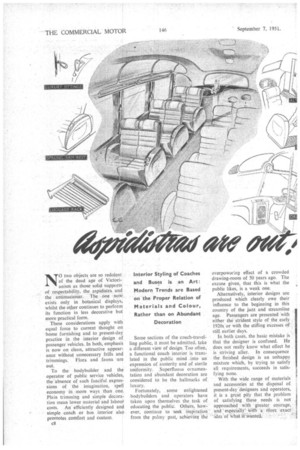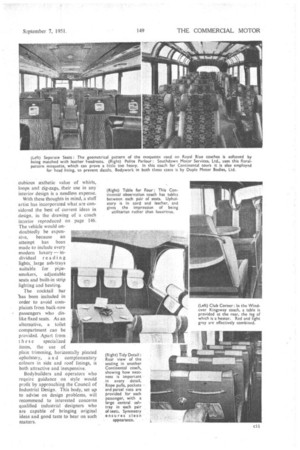Interior Styling of Coaches and Buses is an Art: Modern
Page 44

Page 45

Page 46

Page 47

If you've noticed an error in this article please click here to report it so we can fix it.
Trends are Based on the Proper Relation of Materials and Colour, Rather than on Abundant Decoration
N0 two objects are so redolent of the dead age of Victorianism as those solid supports of respectability, the aspidistra and the antimacassar. The one now exists only in botanical displays, whilst the other continues to perform its function in less decorative but more practical form.
These considerations apply with equal: force to current thought on home furnishing and to present-day practice in the interior design of passenger vehicles. In both, emphasis is now on clean, attractive appearance without unnecessary frills and trimmings. Flora and fauna are out.
To the bodybuilder and the operator of public service vehicles, the absence of such fanciful expressions of the imagination, spell economy in. more ways than one. Plain trimming and simple decoration mean lower material and labour costs. An efficiently designed and simple coach or bus interior also promotes comfort and custom.
c8 Some sections of the coach-travelling public, it must be admitted, take a different view of design. Too often, a functional coach interior is translated in the public mind into an expression of austerity and of sterile uniformity. .Superfluous ornamentation and abundant decoration are considered to be the hallmarks of luxury.
Fortunately, some enlightened bodybuilders and operators have taken upon themselves the task of educating the public. Others, however, continue to seek inspiration from the platy past, achieving the overpoworing effect of a crowded drawing-room of 50 years ago. The excuse given, that this is what the public likes, is a weak one.
Alternatively, interior designs are produced which clearly owe their influence to the beginning in this country of the jazz and streamline age. Passengers are presented with either the strident style of the early 1920s or with the stifling excesses of still earlier days.
In both cases, the basic mistake is that the designer is confused. He does not really know what effect he is striving after. In consequence the finished design is an unhappy mixture which, by trying to satisfy all requirements, succeeds in satisfying none.
• With the wide range of materials and accessories at the disposal of present-day, designers and operators, it is a great pity that the problem of satisfying these needs is not . approached with greater, courage, and ' especially' With a more exact idea of What is'.wanted. In the first place, types of interior design must be clearly defined. In the service bus, function comes first and last, but it .need not look like a hen-house or a hospital waitingroom. Then there is the coach used for excursions and tours, which must have, combined with an air of comfort, an impression of gaiety and informality in keeping with the spirit of the travellers.
Express service vehicles are another category. They must afford comfort of the kind which keeps the passenger at rest and calm throughout anything up to 14 hours of• travel. Lastly, there is the Continental touring coach, catering for a special type of passenger, one who is critical and demanding, but appreciative of good taste.
Each of these classes can, of course, be sub-divided into further categories depending upon the operational conditions and the class of passenger carried.
For the Seaside
For example, a service bus in a seaside resort needs to be bright and clean, but cool and not dazzling in summer weather. In an industrial town, the interior has to be warm , and, above all, easily cleaned, for the effect on a white ceiling of a peakhour load of workmen, all smoking pipes or cigarettes on their homeward run, has given operators much cause for worry: Then, again, there is the country bus, in which usually some attempt is made to introduce the warmth of a farmhouse coupled with the freshness of the fields outside. Where stage-carriage services are operated in particularly picturesque areas, efforts are often made to raise the • standard of visibility as high as that , of a touring coach, whereas in drab moorland, operators attempt to keep
the level of interior illumination high, so that, both by day and night, passengers can divert themselves by reading.
Some concerns find all these conditions within their areas, whilst every coach, during its life, probably passes through every variety of country and town scene. Formidable though the task of meeting so many, and often such conflicting, requirements may be, the designer and operator can console themselves by remembering the wide choice of materials available to them.
There is, first, an infinite range of colour schemes on which to base an interior. Then there are upholstery materials, such as leather, leather cloth, woven plastic and plas
tic sheeting, moquettes and wool cloth for the seats which form the principal part of any coach or bus interior. Interior lining can be carried out in any of these materials or in Formica, plywood or lightalloy panelling.
Windows, sliding roofs, bulkheads and luggage racks can be trimmed with real timber .veneers, Or pressed metal with crackle-enamel or stainless-steel finish.. Chromium plating can be used effectively, if the quantity be restricted, and a new note is struck by employing stove enamelled pressings with a hammered finish or by the use of anodized-aluminium pressings.
Careful selection from this range of materials is essential. Real hide upholstery, set off by contrasting piping gives an air of luxury which is most pleasing. It lends itself also to the type of vehicle in which a " lived-in " appearance is desirable. As a general rule, it is best used in conjunction with veneered panels, or with plastic veneers of identical appearance.
Wool-based upholstery is deservedly popular because of its warm feel, cosy appearance and durability. In some weaves it is combined with mohair to give even longer life and improved appearance. Most materials, including leather and Formica, blend well with -moquettes and repps, and the range of colours available is limitless.
This has resulted, in some cases, in
the choice of an overpowering pattern, which suggests that it was designed purely as an indication of the versatility of the material. Once approved by an operator, the same material may be kept in service on economic grounds when a plainer pattern would be welcomed by everyone concerned.
Colours, too, must be carefully selected. White, people say, is too clinical, green is sickly, browns are gloomy and yellow looks dirty. Nevertheless, in combination and in tasteful shades, every colour has its place in interior design.
Boldness in the use of colour is often rewarding. Many operators stick to colour schemes which have no more to recommend them than that they were selected by the general manager of the tramway company in 1g96.
An easy method of breaking with tradition is to use gaily patterned
upholstery in a vehicle painted or trimmed in neutral colours. London Transport has done this with great effect, and such schemes succeed in satisfying all types of passenger. Of course, a gay interior finish and plain upholstery are equally effective, although plain upholstery may not prove suitable for vehicles constantly in service on routes carrying heavy traffic.
Detail equipment, too, is often a survival of tramway or horsed-bus days. The flaming-torch interior light, the Japanese-sunset seat pedestal, the aspidistra pattern on the front bulkhead—these still exist, and serve only to deepen the furrows on the costing staffs' brows both in the bodybuilder's and the transport manager's offices. Apart from the dubious xsthetic value of whirls, loops and zig-zags, their use in any interior design is a needless expense.
With these thoughts in mind, a staff artist has incorporated what are considered the best of current ideas in design, in the drawing of a coach interior reproduced on page 146. The vehicle would undoubtedly be expensive, because an attempt has been made to include every modern luxury — individual reading lights, .large ash-trays suitable for pipe. smokers, adjustable Seats and built-in strip lighting and beating.
The cocktail bar 'has been included in order to avoid complaints from back-row passengers who dislike fixed seats. As an alternative, a toilet compartment can be provided. Apart from
these specialized items, the use of
plain trimming, horizontally pleated • upholstery, a n d complementary colours in side and roof linings, is both attractive and inexpensive.
Bodybuilders and .operators who require guidance on style would profit'by approaching the Council of Industrial Design. This body, set up to advise on design problems, will recommend to interested concerns qualified industrial designers who are capable of bringing" original ideas and good taste to bear on such matters.
























































































